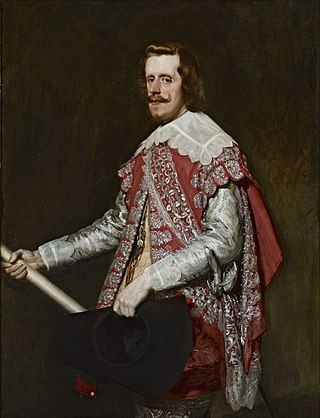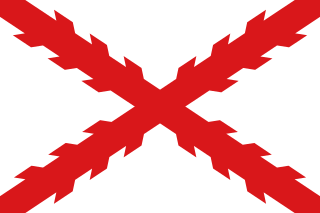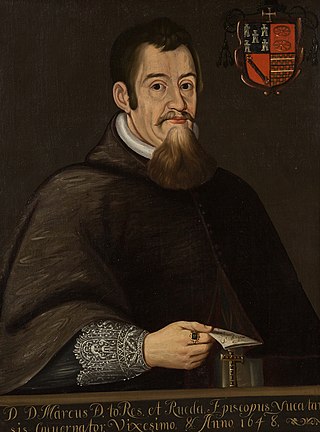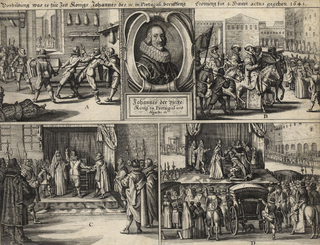This article needs additional citations for verification .(February 2024) |
| |||||
| Decades: | |||||
|---|---|---|---|---|---|
| See also: | Other events of 1648 List of years in Spain | ||||
Events from the year 1648 in Spain
This article needs additional citations for verification .(February 2024) |
| |||||
| Decades: | |||||
|---|---|---|---|---|---|
| See also: | Other events of 1648 List of years in Spain | ||||
Events from the year 1648 in Spain
| | This section needs expansion. You can help by adding to it. (October 2015) |
| | This section needs expansion. You can help by adding to it. (October 2015) |
| | This section needs expansion. You can help by adding to it. (October 2015) |

Philip IV, also called the Planet King, was King of Spain from 1621 to his death and King of Portugal from 1621 to 1640. Philip is remembered for his patronage of the arts, including such artists as Diego Velázquez, and his rule over Spain during the Thirty Years' War.

DomJohn IV, nicknamed John the Restorer, was the King of Portugal whose reign, lasting from 1640 until his death, began the Portuguese restoration of independence from Habsburg Spanish rule. His accession established the House of Braganza on the Portuguese throne, and marked the end of the 60-year-old Iberian Union by which Portugal and Spain shared the same monarch.

The counts of Holland ruled over the County of Holland in the Low Countries between the 10th and the 16th century.

The Treaty of the Pyrenees was signed on 7 November 1659 and ended the Franco-Spanish War that had begun in 1635.

The Eighty Years' War or Dutch Revolt was an armed conflict in the Habsburg Netherlands between disparate groups of rebels and the Spanish government. The causes of the war included the Reformation, centralisation, excessive taxation, and the rights and privileges of the Dutch nobility and cities.

The Spanish Netherlands was the Habsburg Netherlands ruled by the Spanish branch of the Habsburgs from 1556 to 1714. They were a collection of States of the Holy Roman Empire in the Low Countries held in personal union by the Spanish Crown. This region comprised most of the modern states of Belgium and Luxembourg, as well as parts of northern France, the southern Netherlands, and western Germany, with the capital being Brussels. The Army of Flanders was given the task of defending the territory.
The Peace of Münster was a treaty between the Lords States General of the Seven United Netherlands and the Spanish Crown, the terms of which were agreed on 30 January 1648. The treaty, negotiated in parallel to, but not part of, the Peace of Westphalia, is a key event in Dutch history, marking the formal recognition of the independent Dutch Republic and the end of the Eighty Years' War.

Don Lope Díez de Aux de Armendáriz, 1st Marquess of Cadreita was a Spanish nobleman and the first Criollo to be viceroy of New Spain. He served as viceroy from 16 September 1635 to 27 August 1640.

Don Diego García Sarmiento de Sotomayor, 2nd Count of Salvatierra, 2nd Marquess of Sobroso was a Spanish viceroy of New Spain and of Peru. He was the 2nd Count of Salvatierra.

Marcos de Torres y Rueda was bishop of Yucatan (1646–1649), interim viceroy of New Spain, and president of the Audiencia of New Spain. He served in office from May 13, 1648, to April 22, 1649. His name is sometimes given as Marcos Torres y Rueda.

The Franco-Spanish War was fought from 1635 to 1659 between France and Spain, each supported by various allies at different points. The first phase, beginning in May 1635 and ending with the 1648 Peace of Westphalia, is considered a related conflict of the Thirty Years' War. The second phase continued until 1659, when France and Spain agreed to peace terms in the Treaty of the Pyrenees.

The Restoration War, historically known as the Acclamation War, was the war between Portugal and Spain that began with the Portuguese revolution of 1640 and ended with the Treaty of Lisbon in 1668, bringing a formal end to the Iberian Union. The period from 1640 to 1668 was marked by periodic skirmishes between Portugal and Spain, as well as short episodes of more serious warfare, much of it occasioned by Spanish and Portuguese entanglements with non-Iberian powers. Spain was involved in the Thirty Years' War until 1648 and the Franco-Spanish War until 1659, while Portugal was involved in the Dutch–Portuguese War until 1663.
The Treaty of Lisbon of 1668 was a peace treaty between Portugal and Spain that was concluded at Lisbon on 13 February 1668 with the mediation of England in which Spain recognised the sovereignty of Portugal's new ruling dynasty, the House of Braganza.

Christine Marie of France was Duchess of Savoy from 26 July 1630 to 7 October 1637 as the consort of Duke Victor Amadeus I. She was the daughter of Henry IV of France and sister of Louis XIII. Following her husband's death in 1637, she acted as regent of Savoy between 1637 and 1648.

Gaspar de Bracamonte y Guzmán, 3rd Count of Peñaranda was a Spanish diplomat and statesman.
Juan Gómez de Mora (1586–1648) was a Spanish architect, active in the 17th century. He was a main figure of Spanish early-Baroque architecture in the city of Madrid. Spanish art historian Virginia Tovar Martín has published scholarly works on Gómez de Mora.

Roberto de Zúñiga y Velasco was a Spanish royal favourite of Philip III, his son Philip IV and a key minister in two Spanish governments. In control of foreign policy from 1618 to 1622, he was responsible for Spain's initially successful entry into the Thirty Years War (1618–1648) and for the appointment of his nephew, the Count-Duke of Olivares to the position of prime minister for much of the reign of Philip IV. De Zúñiga was also notable as being one of the very few Spanish royal favourites of the period to die whilst still in favour.
Enrique Dávila Pacheco was a royal ambassador of Spain, Acting Governor and Captain General of Yucatán, Governor of Nueva Vizcaya and Governor of Tlaxcala. He was appointed to the position of Governor of Nueva Vizcaya by King Philip IV of Spain.

Guillaume IX d’Hugues was archbishop of Embrun from 16 November 1612 to 27 October 1648 and a diplomat for the French King.
The Great Potosí Mint Fraud of 1649 was a financial fraud involving the fineness of silver coinage that began in Potosí, Spanish Viceroyalty of Peru, now Bolivia. The scandal had worldwide effects that lasted for decades.
![]() Media related to 1648 in Spain at Wikimedia Commons
Media related to 1648 in Spain at Wikimedia Commons